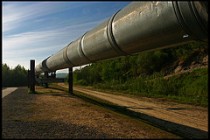Pipe dreams
A proposed $7 billion pipeline to bring Canadian oil sands petroleum to refiners along the US Gulf coast faces local opposition from landowners and environmentalists. Consequently, the US State Department called yesterday for public meetings in the five states to reassess the project.

 Keystone XL is a proposed 1700-mile oil pipeline from the US - Canadian border in Montana, through Oklahoma, to refineries on the US Gulf Coast. The meeting held by the U.S. Department of State is ahead of its expectations to make a decision on whether to grant or deny the permit before the end of 2011.
Keystone XL is a proposed 1700-mile oil pipeline from the US - Canadian border in Montana, through Oklahoma, to refineries on the US Gulf Coast. The meeting held by the U.S. Department of State is ahead of its expectations to make a decision on whether to grant or deny the permit before the end of 2011.
Works on the pipeline restarted last week after the Obama administration had stopped it twice over the past month due to leaks at pump stations in Kansas and North Dakota, which were blamed on faulty fittings.
"Restart of the pipeline will be under restricted conditions and closely monitored," the department said.
In 2008 the State Department announced a presidential permit to Keystone authorizing the construction, maintenance and operation of facilities at the US and Canada border to transport crude oil between the two countries.
After controversy arose regarding the environmental impacts, the State Department released a Draft Environmental Impact Statement (EIS) in April 2010.
However, since the oil spill in the Gulf of Mexico last year, new voices have been calling for a reassessment of the environmental and economic impacts of the pipeline.
Keystone executives have been the project said: "What we've seen over the last several weeks here has almost proven that there's an effective regulative process in place."
To this, a local landowner said: “a spill is a spill. And if they've got one that's shooting a 60 feet geyser of oil in the air, looks like a pretty serious problem to me."
The pipeline marks a major collaboration between the US and Canada and is headed by the TransCanada Corporation. Spokesman Jeff Rauh said that the second federal review of the project, released last month, proves that the route is safe.
But the meeting is overshadowed by legislators in he five states expected to approve the pipeline. In Nebraska the first-round approval was 47-0 to the pipeline bill, two more rounds of debate remain, but approval appears certain.
The American Petroleum Institute, in a letter to Secretary of State Hillary Clinton, said: “We can approve this pipeline and gain access to large amounts of highly secure oil that we know our nation will be consuming in the years ahead. Or we can let our friends to the north find other markets, which they will easily do.”
The US State Department said that once it will finish its EIS review, a 90 day review period will commence and public meetings will be held in all the affected states.
A State Department official said:” These meetings will give the public an opportunity to voice their views on economic, energy security, environmental and safety issues.”
Image: rickz | Flickr


